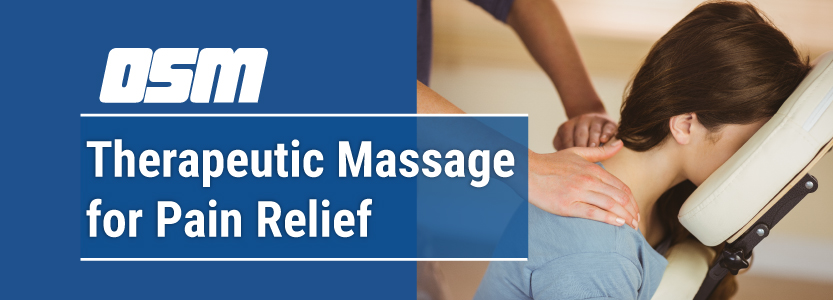Therapeutic Massage for Pain Relief
Article featured on Brigham Health Hub
A therapeutic massage involves the application of the hands or elbows with the intention of solving a physical problem, such as back pain. Alternatively, non-therapeutic or relaxation massage is more passive and is typically used to promote comfort.
“Therapeutic massage can be used to treat a range of conditions, the most common of which is low back pain, followed by neck and shoulder pain. I also use therapeutic massage to treat headaches, jaw pain and Temporomandibular Joint Dysfunction (TMJ),” says Arthur Madore, LMT, a licensed massage therapist at the Osher Center for Integrative Medicine at Brigham and Women’s Hospital.
What are the benefits of therapeutic massage?
Most massage techniques are designed to promote pain relief, stress reduction, and improved movement in daily living.
Therapeutic massage has been shown to improve joint flexibility, relieve lower-back pain, and stimulate the release of endorphins. It can also be used to treat and prevent the following conditions:
- Arthritis
- Sports injuries, work-related injuries, and repetitive strain injuries (carpal tunnel, plantar fasciitis, tendonitis, bursitis)
- Anxiety, depression, tension, and stress
- Walking or running-related pain
- Poor posture and suboptimal use of the body in movement
“Therapeutic massage manipulates the body’s soft tissue, so it also stimulates the flow of fluid in the lymphatic system, which can improve natural immunity. In addition, when received soon after surgery, therapeutic massage can help reduce post-surgery swelling or adhesions,” says Madore.
What are the various massage techniques?
The first massage technique that most therapists learn is Swedish massage which involves the application of oil and is used to promote relaxation.
Other massage styles and techniques include:
- Reiki: Involves light touch, and is designed to work with the body’s energy.
- Craniosacral therapy: Involves only five grams of pressure, and influences the central nervous system.
- Deep tissue massage: Uses intense pressure and targets the deepest layers of muscle tissue, tendons and fascia.
- Rolfing and myofascial release: Involves more aggressive techniques that aim to manipulate the soft tissues.
Madore specializes in Neuromuscular Therapy (NMT), a technique that releases trigger points within tight muscles. NMT is used to create balance among muscle groups to correct postural strain patterns.
“The treatment is based on pain patterns, but also on an assessment of how a patient’s muscle tension is producing twists or other alignment problems,” says Madore.
How often should you visit a massage therapist?
For individuals without a particular problem, visiting a licensed massage therapist once a month is appropriate. For those with a condition such as back pain, it may be appropriate to work with a massage therapist three-to-six times within a short period of time.
The Orthopedic & Sports Medicine Center of Oregon is an award-winning, board-certified orthopedic group located in downtown Portland Oregon. We utilize both surgical and nonsurgical means to treat musculoskeletal trauma, spine diseases, sports injuries, degenerative diseases, infections, tumors and congenital disorders.
Our mission is to return our patients back to pain-free mobility and full strength as quickly and painlessly as possible using both surgical and non-surgical orthopedic procedures.
Our expert physicians provide leading-edge, comprehensive care in the diagnosis and treatment of orthopedic conditions, including total joint replacement and sports medicine. We apply the latest state-of-the-art techniques in order to return our patients to their active lifestyle.
If you’re looking for compassionate, expert orthopedic surgeons in Portland Oregon, contact OSM today.
Phone:
503-224-8399
Address
17355 Lower Boones Ferry Rd Suite 100A
Lake Oswego, OR 97035
Hours
Monday–Friday
8:00am – 4:30pm



